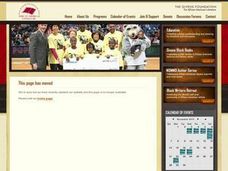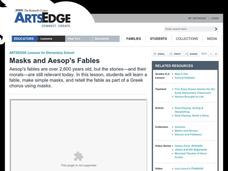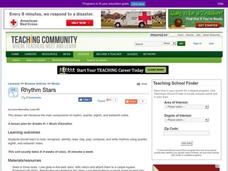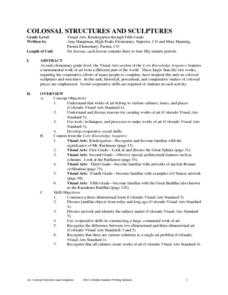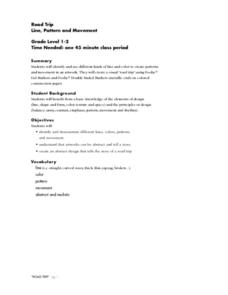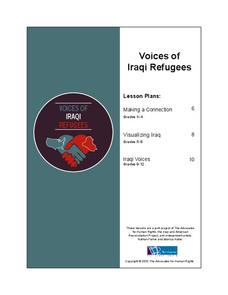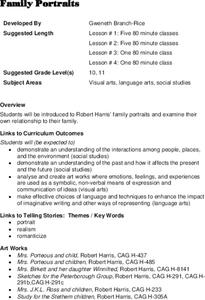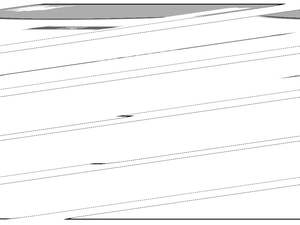Curated OER
Family Origins and American Cultural Pluralism
Young scholars explore, analyze and discuss family origins, special legacies, and racial/cultural groups in literature and art that exposes them to positive examples in African-American history and culture. They encounter examples from...
Curated OER
Framing the Landscape
Students draw their own drawings after learning about composition of drawings and lines. In this drawing lesson plan, students learn about different lines they can use while drawing. Then they go outside and draw their own.
Curated OER
Masks and Aesop's Fables
Students study and perform Aesop's fables. In this Aesop's fables instructional activity, students read and/or listen to a number of the famous fables. They make masks based on the characters and perform a fable using the masks. They...
Curated OER
Create an Illuminated Alphabet Word Book
Students create a class alphabet book. In this letter recognition instructional activity, students use line and color to draw an object whose name begins with a specific letter. Students use adjectives to create a sentence describing the...
Curated OER
Lincoln's Legend and Legacy
Students evaluate Lincoln's impact on American History. In this Civil War lesson, students view a film clip of writings about Lincoln. Students take notes and compare how the writings define his legacy. Students write their own poem or...
Curated OER
Building Classroom Community
Students practice critical-observation and pre-writing skills as they recognize and embrace diversity. They discover how even though all people share some traits, we are also unique and name some physical traits that we all have in...
Curated OER
Rhythm Stars
Learners listen, clap, compose and identify various rhythms. In this rhythm lesson, students practice rhythm with rhythm cards. Learners become familiar with stick notation. Students glue Popsicle sticks to illustrate rhythms.
Curated OER
Doggie, Doggie Where's Your Bone?
Students practice matching pitch. In this lesson on vocal pitch, students sing a silly song that requires them to match their pitch. This song/game also provides a harmless way to get students to sing solos.
Curated OER
Why Is Water So Important to My Community?
Students read and listen to stories and sayings in New Mexico families. Using the text, they discoer the values and beliefs of a culture. They reflect on the meanings of symbols related to water. They discover the importance water has...
Curated OER
A Musical Holiday Gift
Students record a CD of their musical talents and package it for gift giving. They make the CD for either a holiday or end of the year activity.
Curated OER
Looking At People in Portraits
This resource can be adapted for all grade levels! Intended for learners within easy access of the Getty Center, you could still set up a gallery in your own classroom to achieve similar results. Included is a writing prompt, a...
Curated OER
Colossal Structures and Sculptures
Fifth graders explore the historical, procedural, and comparative studies of colossal sculptures and structures in this six lessons unit. The cooperative efforts of many people to complete the works is emphasized.
Curated OER
Road Trip: Line, Pattern, and Movement
Students examine and explore various line, color, and movement elements in artwork. They view and discuss examples of abstract artwork, and create their own original abstract design that tells the story of a road trip.
Safe Routes to School
Pollution & Evolution
Bring together a study of two major scientific topics with a lesson on the relationship between pollution and evolution. With the help of a PowerPoint presentation, hands-on activity. and class demonstration young scientists learn how...
Advocates for Human Rights
Voices of Iraqi Refugees
The stated goal of this resource is to provide learners with basic facts about and build empathy for Iraqi refugees. To do so elementary classes develop a plan for how to welcome refugees to their classroom. Middle schoolers read...
Curated OER
Past and Present New York Through A Comparative Study of Photography and Poetry
Pupils study New York in three time periods, 1890-1930, 1930's, and 1950's-60's. They discuss themes that are important in each time block. They describe a brief historical picture of each time period before they approach works of...
Curated OER
Family Portraits
Students view and discuss realistic family portraits and respond to them by creating abstract art work, form and draw imaginative still life, prepare story about their family history or history of family in community, and write...
Curated OER
Hawaiian Roller Coaster Ride
Learners participate in a partner dance. In this dance lesson, students listen to the song "Hawaiian Roller Coaster Ride" and repeat dance steps according to the music.
Curated OER
Instruments In Action
Students read and demonstrate eight measures of four beats. In this music reading lesson, students read and demonstrate through movement their mastery of eight measures of four beats. Students also classify instruments.
Curated OER
What is Communication
Students recognize the process of communication. In this communication lesson plan, students work in pairs and interview each other. Students report on their two minute interview. Students participate in an activity where students must...
Curated OER
Mesoamerican Codex Books
Fifth graders recreate Mesoamerican Codex Books using brown paper bags, paints, glue, an iron, and books on Mesoamerican Glyphs in this 5th grade activity in the Art classroom. Resource links and book references are provided for...
Curated OER
A Monster's World
Students will use texture to create imaginary monsters and learn about the African American inventor Jan Earnst Matzeliger.
Curated OER
Methods of Mystery
Students utilize the scientific method to discover the age of an item. In this historical dating lesson plan, students compare and contrast a 400 year old cabinet to one made within a few years by using carbon dating. Students complete...
Curated OER
Portrait of a Place, Portrait of a Family
Learners act out stories based on lives of famous people from Harlem. In this memoirs lesson, students compare the life of the people in Harlem in 1930 to the people of today. Learners explore how "home" is different for different...


